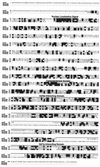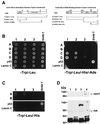Novel Upf2p orthologues suggest a functional link between translation initiation and nonsense surveillance complexes
- PMID: 11073994
- PMCID: PMC86549
- DOI: 10.1128/MCB.20.23.8944-8957.2000
Novel Upf2p orthologues suggest a functional link between translation initiation and nonsense surveillance complexes
Abstract
Transcripts harboring premature signals for translation termination are recognized and rapidly degraded by eukaryotic cells through a pathway known as nonsense-mediated mRNA decay (NMD). In addition to protecting cells by preventing the translation of potentially deleterious truncated peptides, studies have suggested that NMD plays a broader role in the regulation of the steady-state levels of physiologic transcripts. In Saccharomyces cerevisiae, three trans-acting factors (Upf1p to Upf3p) are required for NMD. Orthologues of Upf1p have been identified in numerous species, showing that the NMD machinery, at least in part, is conserved through evolution. In this study, we demonstrate additional functional conservation of the NMD pathway through the identification of Upf2p homologues in Schizosaccharomyces pombe and humans (rent2). Disruption of S. pombe UPF2 established that this gene is required for NMD in fission yeast. rent2 was demonstrated to interact directly with rent1, a known trans-effector of NMD in mammalian cells. Additionally, fragments of rent2 were shown to possess nuclear targeting activity, although the native protein localizes to the cytoplasmic compartment. Finally, novel functional domains of Upf2p and rent2 with homology to eukaryotic initiation factor 4G (eIF4G) and other translational regulatory proteins were identified. Directed mutations within these so-called eIF4G homology (4GH) domains were sufficient to abolish the function of S. pombe Upf2p. Furthermore, using the two-hybrid system, we obtained evidence for direct interaction between rent2 and human eIF4AI and Sui1, both components of the translation initiation complex. Based on these findings, a novel model in which Upf2p and rent2 effects decreased translation and accelerated decay of nonsense transcripts through competitive interactions with eIF4G-binding partners is proposed.
Figures








Similar articles
-
Identification and characterization of human orthologues to Saccharomyces cerevisiae Upf2 protein and Upf3 protein (Caenorhabditis elegans SMG-4).Mol Cell Biol. 2001 Jan;21(1):209-23. doi: 10.1128/MCB.21.1.209-223.2001. Mol Cell Biol. 2001. PMID: 11113196 Free PMC article.
-
Role for Upf2p phosphorylation in Saccharomyces cerevisiae nonsense-mediated mRNA decay.Mol Cell Biol. 2006 May;26(9):3390-400. doi: 10.1128/MCB.26.9.3390-3400.2006. Mol Cell Biol. 2006. PMID: 16611983 Free PMC article.
-
Identification and characterization of mutations in the UPF1 gene that affect nonsense suppression and the formation of the Upf protein complex but not mRNA turnover.Mol Cell Biol. 1996 Oct;16(10):5491-506. doi: 10.1128/MCB.16.10.5491. Mol Cell Biol. 1996. PMID: 8816462 Free PMC article.
-
Nonsense-mediated mRNA decay in health and disease.Hum Mol Genet. 1999;8(10):1893-900. doi: 10.1093/hmg/8.10.1893. Hum Mol Genet. 1999. PMID: 10469842 Review.
-
Transcript selection and the recruitment of mRNA decay factors for NMD in Saccharomyces cerevisiae.RNA. 2005 Sep;11(9):1333-9. doi: 10.1261/rna.2113605. Epub 2005 Jul 25. RNA. 2005. PMID: 16043493 Free PMC article. Review.
Cited by
-
Evaluation of genes from eIF4E and eIF4G multigenic families as potential candidates for partial resistance QTLs to Rice yellow mottle virus in rice.Theor Appl Genet. 2007 Dec;116(1):53-62. doi: 10.1007/s00122-007-0646-6. Epub 2007 Sep 27. Theor Appl Genet. 2007. PMID: 17898986
-
The exon junction complex is detected on CBP80-bound but not eIF4E-bound mRNA in mammalian cells: dynamics of mRNP remodeling.EMBO J. 2002 Jul 1;21(13):3536-45. doi: 10.1093/emboj/cdf345. EMBO J. 2002. PMID: 12093754 Free PMC article.
-
Comparison of nonsense-mediated mRNA decay efficiency in various murine tissues.BMC Genet. 2008 Dec 5;9:83. doi: 10.1186/1471-2156-9-83. BMC Genet. 2008. PMID: 19061508 Free PMC article.
-
Unusual bipartite mode of interaction between the nonsense-mediated decay factors, UPF1 and UPF2.EMBO J. 2009 Aug 5;28(15):2293-306. doi: 10.1038/emboj.2009.175. Epub 2009 Jun 25. EMBO J. 2009. PMID: 19556969 Free PMC article.
-
A Narrow Range of Transcript-error Rates Across the Tree of Life.bioRxiv [Preprint]. 2025 Jan 14:2023.05.02.538944. doi: 10.1101/2023.05.02.538944. bioRxiv. 2025. Update in: Sci Adv. 2025 Jul 11;11(28):eadv9898. doi: 10.1126/sciadv.adv9898. PMID: 39868080 Free PMC article. Updated. Preprint.
References
-
- Atkin A L, Schenkman L R, Eastham M, Dahlseid J N, Lelivelt M J, Culbertson M R. Relationship between yeast polyribosomes and Upf proteins required for nonsense mRNA decay. J Biol Chem. 1997;272:22163–22172. - PubMed
-
- Bassett D E, Jr, Boguski M S, Spencer F, Reeves R, Goebl M, Hieter P. Comparative genomics, genome cross-referencing and XREFdb. Trends Genet. 1995;11:372–373. - PubMed
-
- Beelman C A, Parker R. Degradation of mRNA in eukaryotes. Cell. 1995;81:179–183. - PubMed
Publication types
MeSH terms
Substances
Associated data
- Actions
- Actions
Grants and funding
LinkOut - more resources
Full Text Sources
Other Literature Sources
Molecular Biology Databases
Research Materials
